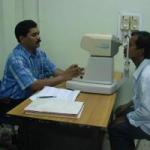A man who lost his vision to a degenerative eye disease has regained some of his sight with the help of a high-tech "bionic eye," in a procedure that experts have called a "game-changer."
55-year-old Roger Pontz was diagnosed with retinitis pigmentosa as a teenager, and has been completely blind for years.
Since doctors operated on Mr Pontz and implanted an artificial retina into his left eye, he has regained enough of his eyesight to see his friends and family for the first time - including his wife.
The former competitive weightlifter and factory worker is one of four people in the US to receive the treatment at a facility in Ann Arbor, since the Food and Drug Administration rubber-stamped its use last year.
Dr Thiran Jayasundera, one of two physicians who performed the 4.5-hour surgery on Mr Pontz, has called the surgery a "game-changer."
"It's awesome. It's exciting — seeing something new every day," Mr Pontz told reporters at a recent appointment at the University of Michigan Kellogg Eye Center.
"I can walk through the house with ease. If that's all I get out of this, it'd be great," he added.
Retinitis pigmentosa is an inherited disease that causes slow but progressive vision loss due to a gradual loss of the light-sensitive retinal cells called rods and cones. Patients experience loss of side vision and night vision, then central vision, which can result in near blindness.
While Mr Pontz's treatment was successful, not all of the 100,000 people in the US who suffer from the disease can be helped by an artificial retina.
Candidates must be 25 or older with end-stage retinitis pigmentosa that has progressed to the point of having "bare light" or no light perception in both eyes.
An estimated 10,000 have vision low enough, said Dr Brian Mech, an executive with Second Sight Medical Products Inc., the Sylmar, California-based company that makes the device. Of those, about 7,500 are eligible for the surgery.
The artificial retina procedure has been performed several-dozen times over the past few years in Europe, and the expectation is that it will find similar success in the US, where the University of Michigan is one of 12 centres accepting consultations for patients.
The implant uses a small video camera and transmitter housed in a pair of glasses which captures images.
These are converted into a series of electrical pulses that are transmitted wirelessly to an array of electrodes on the surface of the retina. The pulses stimulate the retina's remaining healthy cells, causing them to relay the signal to the optic nerve.
The visual information then moves to the brain, where it is translated into patterns of light that can be recognized and interpreted, allowing the patient to regain some visual function.
Please share
s.s.venkateshwar
A& N islands

 Comments (
Comments ( Category (
Category ( Views (
Views (